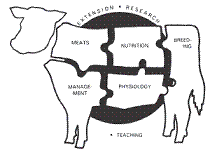Animal Science, Department of

Nebraska Beef Cattle Reports
Date of this Version
January 1996
Abstract
P. ruminicola is a predominant member of the rumen microflora, and in addition to its important role in fiber digestion, it is one of the major proteolytic bacteria from the rumen. It is capable of using both large peptides and ammonia as its nitrogen source, but not free amino acids, small peptides. and other low molecular weight N compounds. Also. prior growth with peptides appears to inhibit ammonia assimilation. and results in fermentation uncoupled from microbial growth. so called “energy spilling”.
For the great majority of grazing ruminants. ammonia is the major N source in the rumen. and it is imperative to maximize microbial protein synthesis per unit of energy fermented. However, little is known about ammonia assimilation and N regulation in rumen bacteria that possess a quantitatively important role in fiber digestion, such as P. ruminicola. We report here a preliminary characterization of an NADPH-dependent glutamate dehydrogenase (GDH), the major enzyme involved with ammonia assimilation in P. ruminicolastrain B14.


Comments
Published in 1996 Nebraska Beef Cattle Report; published by Agricultural Research Division, Institute of Agriculture and Natural Resources, University of Nebraska-Lincoln.